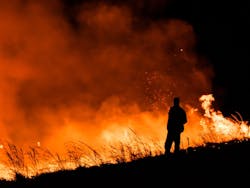Pacific Gas & Electric (PG&E) may speed development of 40 microgrids to help customers maintain electricity when wildfire threats force it to deenergize portions of its grid.
The utility described its plans Friday in a four-hour emergency meeting called by the California Public Utilities Commission (CPUC) in response to the October 9-12 shutoffs to 2 million customers (738,000 accounts).
“There is a definite need to move toward some form of microgrid sectionalization,” PG&E CEO William Johnson told the commission.
On windy days California utilities have been undertaking public safety power shutoffs (PSPS) — intentional electricity shutoffs — because several wildfires in the state have been linked to their equipment.
Customers have expressed anger in the press and at the commission meeting over the shutoff. San Jose is considering exiting from PG&E’s service to run its own utility that would focus on microgrids.
We know we have to do better
During Friday’s hearing, Sumeet Singh, vice president of PG&E’s Community Wildfire Safety Program, described plans to accelerate development of what the utility calls “resilience zones,” areas of the grid configured to act as microgrids with temporary, mobile generation. Eventually the utility may develop them into permanent microgrids, according to PG&E’s 2018 wildfire mitigation plan.
One zone is already operating in Angwin, a town in Napa County. The project taps into cogeneration at Pacific Union College and provides power for a fire station, gas station, apartment building and a plaza.
The utility had planned to develop 40 or more of the microgrid configurations over three years. “But we know we need to do better and we are in the process of re-evaluating our plans to identify what we can get done and how quickly we can get some of these things done in a safe manner.”
Singh said that the utility is prioritizing microgrids for sites that are susceptible to ignition and wildfire, experience high winds, and offer limited egress for the population.
In addition to developing microgrids, PG&E officials said they are hardening the grid, which includes installation of covered conductors, and increasing vegetation management. The utility also is installing reclosers and other equipment to sectionalize parts of the grid and limit the number of customers affected by a power shutoff. So far PG&E has installed 200 sectionalization devices, which helped avert power outages to 77,000 customers during the shutoff.
But with a 70,000 square-mile service territory, the utility acknowledges that grid modernization will take time, as long as 10-14 years to complete. Johnson foresees the potential for shutoffs over the next decade.
“It will get better every year, but will take 10 years until it is ratcheted down significantly,” the CEO told the commission.
The utility reported that damage to its system from the wind justified the mid-October shutoff. In a news release, PG&E said it found 100-plus incidents of damage that could have caused fires had lines been live.
PG&E Plan to Improve Service & Resiliency
Credit: PG&E’s Presentation at Oct. 18, CPUC 2019 Emergency Meeting







